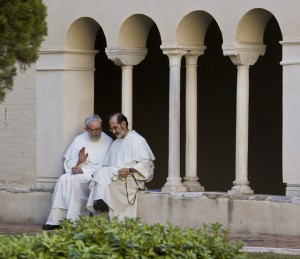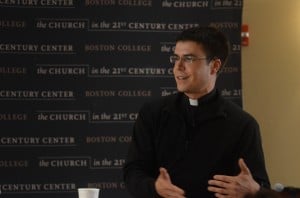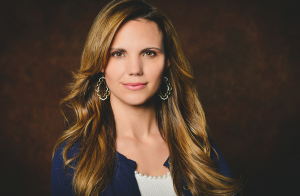
drawing of the Crucifixion
Image: Wikimedia Commons
Let me set the scene for you with two examples:
1. Stanza XXVII from St. John of the Cross’s Spiritual Canticle:
There He gave me His breasts,
There He taught me the science full of sweetness.
And there I gave to Him
Myself without reserve;
There I promised to be His bride.
Without reading too much into this, it’s not hard to imagine that John of the Cross experienced some same-sex attractions. I’m not saying that John of the Cross was gay. There was no narrative around at his time for him to be “gay.” But I think it’s not that far fetched to imagine that many of our saints have had varying experiences of same-sex attraction, and that it was because of and not despite these attractions that they developed such rich spiritualities.
2. Most of us know a priest that we suspect might be gay. Many of us think they are pretty good at their ministry. So does Pope Francis I suspect. As he said at the very end of his famous airplane interview:
The problem is not having this [same-sex] tendency, no, we must be brothers and sisters to one another.
In my experience, many priests who experience same-sex attraction are fantastic ministers. Their presence in the Church is not going away.
In other words, there seems to be a growing recognition in Catholic circles that not everything about same-sex attraction is disordered. That there is a deep wellspring of human sexuality out of which many positive opposite-sex and same-sex attractions arise. At least I am beginning to grow in this recognition (my experience is almost entirely with men) and that is why I’m writing this piece.
So I want to look at three typical responses to the reality of same-sex attraction in the Catholic Church: 1. Everything about same-sex attraction is disordered; 2. Everything about same-sex attraction is OK; 3. The Church’s teaching on this matter can be interpreted narrowly to refer only to same-sex genital expression, and outside of this, same-sex attraction can be expressed in many positive ways.
First, there exists a certain group of Catholics who think that everything about the same-sex “orientation” is disordered. There can be no positive expression of same-sex attraction by a person who is disordered in this particular way. Daniel Mattson writing at First Things puts it this way, and in so doing, he speaks for many Catholics I know:
Sexual acts between members of the same sex are intrinsically disordered, for the reason that there is never (and can never be) any positive reordering of the sexual faculty to what is true, good, and beautiful between two members of the same sex.
In other words, there is an extremely close equation made between same-sex desire for acts of genital expression and all other expressions of same-sex desire. It’s thus something of a zero sum situation, all or nothing. All expressions of same-sex desire are disordered, and so all of the attractions of a same-sex oriented person must be mortified. There is no other alternative.
And so I’m writing because that is not my position, and for the most part, that is not my position because that is not my experience (nor do I believe that the Church asks me to accept that position). In my experience (which comes entirely from friendships with men), there is a way in which same-sex attracted people express themselves that is good not despite but also precisely because of their same-sex attractions.

Image: blackboard1965 / Shutterstock
Second, there is another group of Catholics, as we all know, who find the teaching of the Church on this matter to range anywhere from problematic to outright discriminatory. For these Catholics, such as the highly respected theologian James Alison, it makes no sense to speak of a disordered approach to sexual flourishing, when there has been nothing physiologically or psychologically shown to be wrong with those who have these desires. He directs us (in a fantastic interview with Brett Salkeld) to the analogy of a person who is left-handed but is not allowed to act in any left-handed ways. He explains:
Now, imagine that, involved in a Catholic discussion, you find yourself addressing a left-handed person. You say: “Any left-handed writing you do is intrinsically wrong; and in fact the inclination we call left-handedness must be considered objectively disordered.”
For many of these Catholics, the best thing to do is provide a welcome space within the Church for gay Catholics and reassure then quietly that the Church’s teaching on this matter will eventually change.[1. In a similar way that it eventually changed its teaching, e.g., on slavery, or religious liberty. A position I disagree with. For a thorough response to the idea that the Church has changed rather than developed its teaching on these matters, see the ever balanced Avery Cardinal Dulles. The Church’s teaching on sexuality has developed quite a bit over the last century, on the other hand, and probably will continue to do so.] These Catholics will often quote Dorothy Day to represent how they feel about the Church on this matter: “Though she is a harlot at times, she is our mother.” They are ashamed of the Church’s teaching on homosexual practices and on sexuality in general, but since the Church is their family, rather than leave, they remain and work and hope for change from within.
While I have tremendous respect for such Catholics, I am also not one of them. I accept the Church’s teaching that homosexual acts are disordered.
Then there’s a third group. This has become my group. According to this group, the human wellspring of sexuality is so deep, that it is neither reducible to nor exhausted by genital expression. One particular disordered expression of same-sex sexuality (the part that desires same-sex genital expression) is not emblematic of a person’s whole sexuality. According to that group, there are so many ways of experiencing same-sex attraction, just as there are so many ways of experiencing opposite-sex attraction, that it can be unhelpful to lock those two into “orientations.” Experiences of human sexuality have become so diversified (and they probably always have been) that it is unclear how the language of “orientation” is even helpful anymore.
Now I’m not saying that some people are not born with strong predispositions to people of the opposite sex and others are not born with strong predispositions to people of the same sex. People, as they grow, often experience their attractions in a complex variety of ways. There are people whose primary interest is in people of the opposite sex who also have some same-sex fantasies, and vice-versa.
So, let’s describe how this third group thinks. A person has predominantly same-sex attractions, although he also has some opposite sex attractions now and then. What I’m asking is: Can such a person not experience his predominant same-sex attractions in a spiritually, relationally, and ministerially very positive way?
Let me adapt the left-handed metaphor that James Alison raised. Group three is not saying that the whole left-handed inclination is disordered. Only one form of left-handed expression is disordered (the desire for same-sex genital expression). Left-handedness itself is not disordered as a result, nor is the use of the left hand, and there are myriads of other forms of left-handed activity that can be positively expressed.
This is the position that I agree with over at the Spiritual Friendship blog. They, a group of same-sex attracted bloggers, say things like:
Our same-sex love can “express itself as chaste friendship or mystical approach to God rather than as gay sex.”
Wesley Hill, one of their regular contributors, continues:
What we, in modernity, have chosen to call a “homosexual orientation” (or “being gay”) includes much of what Scripture and the Christian tradition commend as Christian virtues.
One of these virtues is the ability to form bonds of deep friendship with members of the same sex. He concludes that writers at Spiritual Friendship understand
“same-sex attraction” or “being gay” as broader, more inclusive categories that can’t be reduced to the behavior, or even the desire for, gay sex. Just as chaste chivalry, to take just one example, can be an expression of heterosexuality, so we’re suggesting that chaste friendship (or a number of other ways of expressing love) can be an expression of homosexuality.
Nor are these positive expressions of one’s same-sex attractions simply an expression of “anonymous straightness.”[2. Sorry theologians, I hear your groans. The term is adapted from Karl Rahner’s “anonymous Christianity,” referring to those members of non-Christian religions who, on account of their devotion to the truth and commitment to existential authenticity, implicitly respond to grace offered by Christ, thereby making them “anonymous Christians.”] This is an opinion that I often hear: Aren’t the positive virtues of someone with same-sex attraction just good “straight” virtues that have been long forgotten about? Well, I’d rather put it this way: The positive virtues of someone with same-sex attractions are expressions of the rich wellspring of human sexuality, a richness that can never be exhausted by anyone, wherever they are along the spectrum.
And so there are depths to human sexuality that can be expressed by someone with same-sex attractions that are not available to someone who only experiences opposite-sex attraction. That is the core claim of group three.

Image: Fr. Lawrence Lew, OP / Flickr Creative Commons
Let me turn now to three areas of life that often involve a tremendous amount of sexual expression in order to develop my point.
Spirituality. There is a richness to same-sex expressions of spirituality that are separable from the desire for genital expression. John of the Cross’ Stanza XXVII, for example, is my case and point. Go read it again. It speaks to me of 1. A beautiful spiritual expression here of same-sex attraction and love that 2. Does not have to have anything to do with “orientation,” and which 3. Someone with predominantly opposite-sex attractions may not be capable of having. But this poem is a quite comforting spirituality to many others and has been a profound source of a rich spirituality throughout the centuries. Again, not saying that John of the Cross was gay. But I’m pointing to a wellspring of human sexuality that can include positive expressions of same-sex attraction.
Friendship. It has been my experience as well that often friendships with those who have same-sex attractions grow and develop richly as a result of those attractions and not despite them. There is something helpfully intuitive about friends with same-sex attractions that allows them to empathize with other men in ways that many men attracted to the opposite sex cannot. In my experience, my friendship with certain men has been very rich very much because of the fact that they experience same-sex attraction.
And I have to say, that was not what I expected. I was intellectually raised in college along the lines of the first group described at the beginning of this essay. And so it was as a result of my friendship (as opposed to mere acquaintance) with some actual men with same-sex attraction that convinced me of this point. I realized that it was certain aspects of their preferences that made them such good friends, friends who could listen, goof around, share deeply about prayer and have a drink. Basically, my reasoning ran as such: 1. If his friendship with me is a profoundly beautiful experience of human love; and 2. If the capacity for relationality that his friendship entails is rooted in the depths of his sexuality, then 3. There must be a rich component of his same-sex attracted sexuality that is not reducible to his desire for genital expression.
Apostolic Effectiveness. Many men with same-sex attractions have been profoundly successful in ministry, both within the priesthood and outside of it, again, as a result of, it would seem, and not despite their particular sexuality. That is at least my observational experience. Many of us know very successful priests who experience same-sex attraction. Can it really be that they are successful only because they have completely eliminated from their lives everything about their same-sex sexual preferences? If sexuality “affects all aspects of the human person” (as the Catechism teaches in n. 2332), then what would be left for them in ministry? How could they continue to be such relationally compassionate and empathetic people? No, they are so effective in a large degree because of their attractions, and it is time that bishops begin publicly to affirm, as Elizabeth Scalia challenges, “the numerous celibate homosexual priests who, throughout history and still today, serve her faithfully, courageously, and with great joy.”
There is a way in which their “being” of their same-sex attractions, their “fulfilling” of these attractions is positive. And so just to reiterate my thesis: There is much to same-sex attraction, drawing as it does from the deep wellspring of human sexuality, that is not reducible to the desire for genital expression. As Melinda Selmys expresses it so beautifully:
Being gay is not reducible to having, or desiring to have, homosexual sex. It is a way of relating to other people, a way of appreciating human beauty, and a way of relating to one’s own gender.
So what I ask and welcome are any helpful comments about how to think about these realities. I’m curious as to whether others interpret the Church’s teaching in the same way and what they think it means practically. I’m also curious as to whether others have found my observational ramblings to match their experience.
— — —
Editor’s note: before you comment, we refer you once again to our comment policy. For good reasons on both sides of this issue, these discussions can often become heated. Please extend to others the charity of understanding their positions before you disagree with them, and entering into dialogue rather than diatribe. We will moderate as much as necessary in an attempt to make this discussion work.
Comments will be closed at the end of this week.
— — —











